Well, no, not really. I have only just started to tackle the great deal of skills and knowledge I will need to acquire on my journey to the launchpad. Still, the seven days I spent kayaking and camping in Alaska this last September under the expert guidance of two wonderful NOLS instructors, Josh and Ashley, taught me a lot of lessons that will hopefully make me a better crewmember on the International Space Station.
NOLS expeditions are one of several space-analogue training environments that are meant to foster team-building and to practice “human behaviour and performance” skills – intangible, yet invaluable personal assets ranging from leadership/followership and decision making to self-awareness and communication, just to name a few. (Two more such analogue training environments are NEEMO and CAVES – if you haven’t already, go and read Tim’s and Andy’s accounts on this blog!)
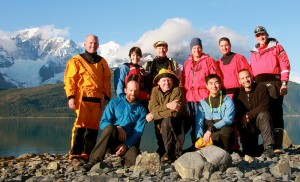
Group picture at Herring Canal. Took advantage of the sunny afternoon to take our group picture! Photo courtesy Ashley Wise, NOLS
I had the privilege of sharing the experience with three veteran NASA astronauts and military aviators – Jeff Williams, Terry Virts and Barry “Butch” Wilmore – and two members of our “Shenanigans” NASA/JAXA sister class, the “Chumps”: Kimiya Yui, himself a military test pilot, and Kjell Lindgren, an emergency medicine physician and former flight doc. And of course the team would not have been complete without some outstanding representatives of the ground operations folks: CAPCOM Hal Getzelman and Expedition 42 Lead Flight Director Tomas Gonzalez Torres.
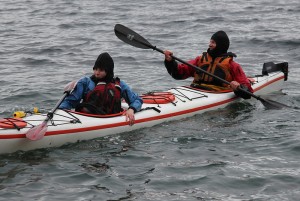
Back into the kayak. On the first day we had to show that, in case we rolled over, we would be able to extract ourselves from the capsized kayak, roll it back and climb into the cockpit. For extra practice, we did it three times…unintentionally 🙂
Photo courtesy Ashley Wise, NOLS
We set out for an ambitious week-long kayaking itinerary – tents, tarps, fuel and kitchen supplies to be packed in our kayaks on the way from one campsite to the next, exploring the beauties of Prince William Sound on the way.
But September Alaska weather forced us to change our plan considerably. Higher seas than our kayaking skills could master prevented us from paddling on several days. Strong winds forced us to change our focus towards maintaining a safe and functional campsite, while chilly temperatures and pouring rain were our most faithful companions. Yet we had a great time together and we learned a lot about each other and about facing challenges as a team.
Here are some lessons I want to remember and to share.
1. Be respectful and take interest in others.
Looking back at our week in Alaska, I can’t help to marvel at the warm atmosphere and people’s good spirits, even though we were chilled, wet and forced into inactivity for several days by adverse weather. I think we were a group with a good tolerance for adversity, but what really made us strong, in my opinion, is the unconditional respect we offered one another and the genuine interest we took in each other.
2. Always pay attention to details. No excuses.
It is taken for granted that astronauts possess the skills required for a spaceflight: years of training are devoted to making sure that that is the case. What makes the difference in daily work is the attention you put into every detail. In the field or in space, physical discomfort can be distracting, but it’s no excuse. Your fingers might be numbed by the cold water and you might be looking forward to changing into warmer clothes, but you still need to devote all the necessary time and attention to each one of those knots, to make sure the tent is properly secured. When the winds pick up at night, you’ll be happy you did so.
3. Actively think of ways you can help.
Be it filling up bags of water at the stream, moving a tent that was about to be flooded, heading out in the rain to do the dishes at the shore or boiling water for the group, during the entire trip every task was immediately and spontaneously tackled by somebody noticing the need and volunteering to take care of it. I suspect that this is how the best ISS crews function.
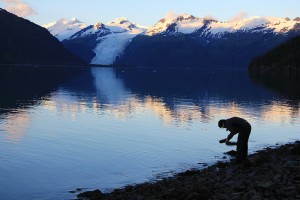
Washing dishes on the shore. No soap – just a lot of scrubbing with the gravel! Photo courtesy Ashley Wise, NOLS
4. Take care of your gear.
Whether on a remote campsite in Alaska or on the ISS, you can’t just stop at the shop for new clothes or equipment. And yet it requires discipline and a conscious effort to even simply keep track of all your gear. It took me until the end of the trip to find a reasonable way of organizing my water proof bags – and I was still on the learning curve. No surprise that inventory management is a big issue on ISS.
5. Take care of yourself.
Taking care of yourself is the first step in discharging your duties towards the group. If you neglect taking care of yourself, you’ll become a liability to the team. In the field or in space, it’s your responsibility to stay healthy and in good spirits!
6. Seek help when you need it. If you’re offered help, accept it.
In spite of your best efforts of taking care of yourself, you might be in need of some help occasionally. Speak up and ask for help, as long as the problem is still manageable. Accept the help that is offered to you. Thanks so much Ashley for offering that warm cap and that thermos of hot water when my lips were turning blue in the kayak!
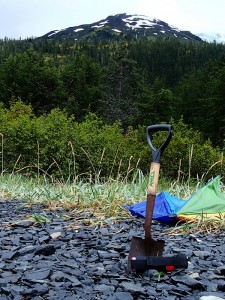
The kit for the “trip in the bush”. A shovel to dig your toilet and pepper spray in case a bear heads your way.
7. Clean up after yourself.
On the Alaskan campsites or on the ISS, nobody wants to clean up your mess. Leave the place as you found it, or maybe a bit better. Even if it means digging a “toilet” with a shovel and using sphagnum moss instead of toilet paper.
8. Overcome inertia.
Pretty early on our trip we were forced to accept the fact that the adverse weather would not allow us to kayak most of the time. In fact, when hurricane-strength winds were forecast in the Prince William Sound area we had to shift the focus from kayaking to evaluating risks related to weather and on mitigating them by appropriate campsite selection and setup. However, on our last full day in the field the weather seemed to allow at least some chance of kayaking about 12 miles and moving camp outside of our protected channel. Yet the chilly wind and the pouring rain didn’t make the thought very attractive.
It would have been easy to settle in the routine we had been forced into, possibly just venturing out for some local paddling, knowing that we would be able to come back to our familiar campsite. No risk of hypothermia, no uncertainty related to weather outside our canal or to the new campsite. Yet after some discussion we decided that all risks and uncertainties were manageable. We were able to break the trap of inertia and challenge ourselves to really move camp for the first time through rather harsh weather conditions. When we arrived to our destination at Hobo Bay, we were rewarded by the intense beauty of our new campsite and by an unexpected gift – a break in the rain in the evening hours! But our greatest reward was a genuine sense of team accomplishment.










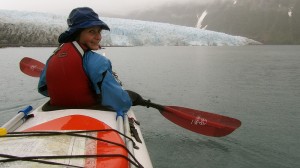
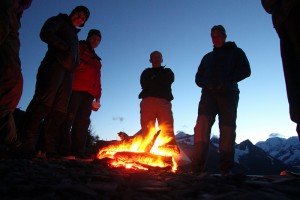
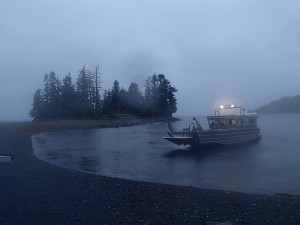
Discussion: 8 comments
Thank you for sharing this with us. These are important advice that I’ll keep in mind until the next selections and longer after that. You are talking about NEEMO and CAVES as similar training, so what makes ESA to choose to send you there and not somewhere else? Why not NEEMO, why Tim was picked?
Thank you!
This NOLS expedition is part of my Expedition 42 training flow. As for other trainings, like NEEMO, it’s partly availability and partly other considerations case-by-case. There is no general answer.
Abudant thanks 4 the post: its useful even 2 any other teamwork.
I think so too. Thanks for your feedback!
Hello
I have a question: Can we use one of the picture above, campfire from Ashley Wise, for a packaging of a christmas giveaway. It should be print on a packaging where a barbeque rod is inside. We are a manufacturer of clamping tools in Germany. Please give me a short notice, whether this is ok or not. Thanks very much.
Ehm… it’s an unusual request for sure, but I don’t see why not. Thanks for asking.
Bellissimo brano Sam, che esemplifica molto bene l’importanza del vostro training ed il modo in cui vi è utile.
Le cose che avete imparato sono importanti non solo ad un astronauta, ma a chiunque si accinga a vivere un’esperienza di gruppo di un certo livello.
Lo salvo tra i miei preferiti….. ed In Bocca al Lupo per la Missione Futura ! 🙂
Crepi il lupo e grazie del tuo feedback!